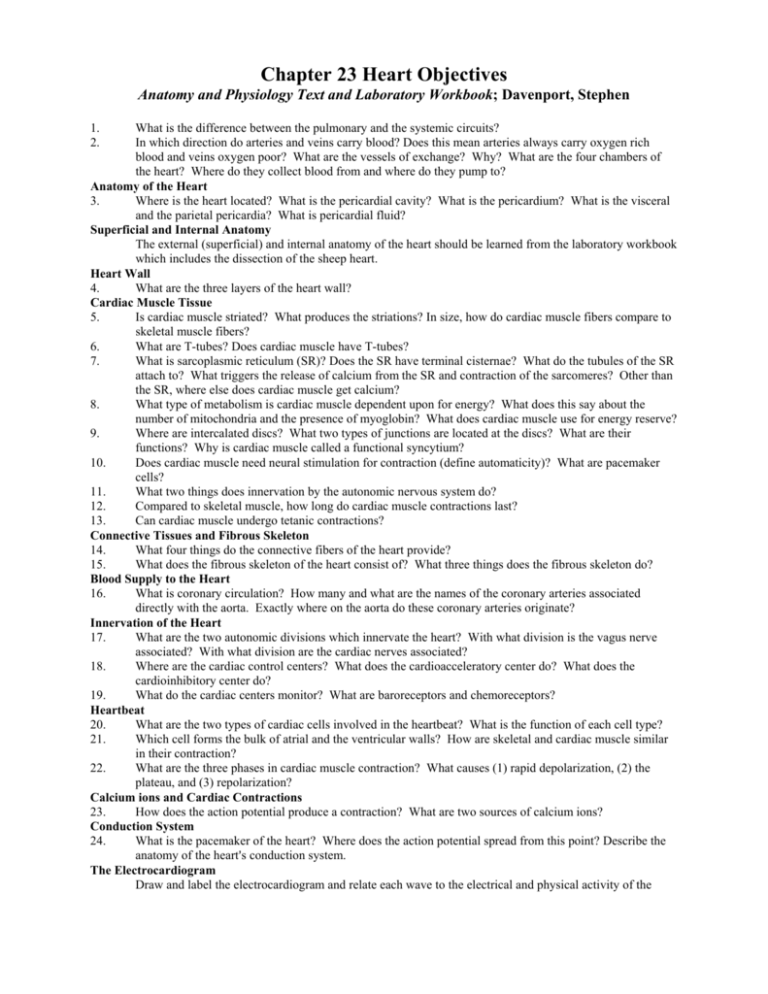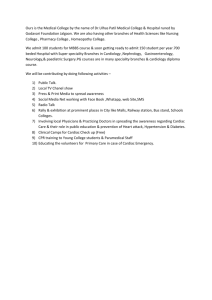Objectives for the Heart
advertisement

Chapter 23 Heart Objectives Anatomy and Physiology Text and Laboratory Workbook; Davenport, Stephen 1. 2. What is the difference between the pulmonary and the systemic circuits? In which direction do arteries and veins carry blood? Does this mean arteries always carry oxygen rich blood and veins oxygen poor? What are the vessels of exchange? Why? What are the four chambers of the heart? Where do they collect blood from and where do they pump to? Anatomy of the Heart 3. Where is the heart located? What is the pericardial cavity? What is the pericardium? What is the visceral and the parietal pericardia? What is pericardial fluid? Superficial and Internal Anatomy The external (superficial) and internal anatomy of the heart should be learned from the laboratory workbook which includes the dissection of the sheep heart. Heart Wall 4. What are the three layers of the heart wall? Cardiac Muscle Tissue 5. Is cardiac muscle striated? What produces the striations? In size, how do cardiac muscle fibers compare to skeletal muscle fibers? 6. What are T-tubes? Does cardiac muscle have T-tubes? 7. What is sarcoplasmic reticulum (SR)? Does the SR have terminal cisternae? What do the tubules of the SR attach to? What triggers the release of calcium from the SR and contraction of the sarcomeres? Other than the SR, where else does cardiac muscle get calcium? 8. What type of metabolism is cardiac muscle dependent upon for energy? What does this say about the number of mitochondria and the presence of myoglobin? What does cardiac muscle use for energy reserve? 9. Where are intercalated discs? What two types of junctions are located at the discs? What are their functions? Why is cardiac muscle called a functional syncytium? 10. Does cardiac muscle need neural stimulation for contraction (define automaticity)? What are pacemaker cells? 11. What two things does innervation by the autonomic nervous system do? 12. Compared to skeletal muscle, how long do cardiac muscle contractions last? 13. Can cardiac muscle undergo tetanic contractions? Connective Tissues and Fibrous Skeleton 14. What four things do the connective fibers of the heart provide? 15. What does the fibrous skeleton of the heart consist of? What three things does the fibrous skeleton do? Blood Supply to the Heart 16. What is coronary circulation? How many and what are the names of the coronary arteries associated directly with the aorta. Exactly where on the aorta do these coronary arteries originate? Innervation of the Heart 17. What are the two autonomic divisions which innervate the heart? With what division is the vagus nerve associated? With what division are the cardiac nerves associated? 18. Where are the cardiac control centers? What does the cardioacceleratory center do? What does the cardioinhibitory center do? 19. What do the cardiac centers monitor? What are baroreceptors and chemoreceptors? Heartbeat 20. What are the two types of cardiac cells involved in the heartbeat? What is the function of each cell type? 21. Which cell forms the bulk of atrial and the ventricular walls? How are skeletal and cardiac muscle similar in their contraction? 22. What are the three phases in cardiac muscle contraction? What causes (1) rapid depolarization, (2) the plateau, and (3) repolarization? Calcium ions and Cardiac Contractions 23. How does the action potential produce a contraction? What are two sources of calcium ions? Conduction System 24. What is the pacemaker of the heart? Where does the action potential spread from this point? Describe the anatomy of the heart=s conduction system. The Electrocardiogram Draw and label the electrocardiogram and relate each wave to the electrical and physical activity of the heart. Cardiac Cycle 25. What is a cardiac cycle? Define systole and diastole. Why does blood flow? What prevents its back flow? Atrial Systole 26. How much blood is already in the ventricles at the start of atrial systole? How much does atrial systole fill the ventricle? What is end-diastolic volume (EDV)? Ventricular Systole 27. What is isovolumetric contraction? When does ventricular ejection occur? Define stroke volume and endsystolic volume (ESV). Heart Sounds 28. Describe the heart sounds. Cardiodynamics 29. Define cardiac output. What is the equation for its calculation? 30. What is the Frank-Starling law? Contractility 31. What is the effect of sympathetic and parasympathetic stimulation on contractility? 321. What are the effects of hypercalcemia and hypocalcemia? What other ion effects heart rate and contraction? 33. Define bradycardia and tachycardia.






